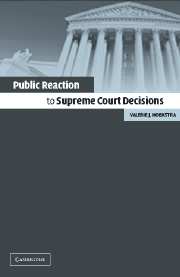Book contents
- Frontmatter
- Contents
- List of Figures
- List of Tables
- Acknowledgments
- 1 The High-Wire Act: The Supreme Court and Public Opinion
- 2 From the Marble Temple to Main Street: Placing the Cases in Political and Legal Context
- 3 Media Attention and Public Awareness
- 4 Changing Hearts and Minds? Examining the Legitimation Hypothesis
- 5 Public Support for the Supreme Court
- 6 Conclusion: Balancing Independence and Support
- Appendix A Sampling
- Appendix B Survey Instruments Included in the Analysis
- Appendix C Local and National Media Coverage of a Sample of Supreme Court Cases: 1996–97 Term
- Appendix D Statistical Issues with the Analysis of Panel Data
- References
- Index
Appendix D - Statistical Issues with the Analysis of Panel Data
Published online by Cambridge University Press: 02 September 2009
- Frontmatter
- Contents
- List of Figures
- List of Tables
- Acknowledgments
- 1 The High-Wire Act: The Supreme Court and Public Opinion
- 2 From the Marble Temple to Main Street: Placing the Cases in Political and Legal Context
- 3 Media Attention and Public Awareness
- 4 Changing Hearts and Minds? Examining the Legitimation Hypothesis
- 5 Public Support for the Supreme Court
- 6 Conclusion: Balancing Independence and Support
- Appendix A Sampling
- Appendix B Survey Instruments Included in the Analysis
- Appendix C Local and National Media Coverage of a Sample of Supreme Court Cases: 1996–97 Term
- Appendix D Statistical Issues with the Analysis of Panel Data
- References
- Index
Summary
The primary data analyzed in this book are collected from a series of panel studies. Since there are some statistical issues with this kind of analysis, I include a brief discussion of those problems and issues in this appendix, but this section is not essential to understand the analysis presented in the empirical chapters. Specifically, there are various concerns with how the dependent variables are measured. In panel studies, there are a number of approaches to analyzing effects over time. Two of the most common groups of approaches are “change score” models and “regression adjustment” or “static score” models (Judd and Kenney 1984; Finkel 1995). Each of these models improves upon standard cross-sectional approaches by incorporating the dynamic components, but in so doing they can suffer from a different set of statistical problems.
The “change score” method uses simple differences between the level of the dependent variable at the various time points. In a two-wave study, the change score is simply the difference between the dependent variable at the first and second measurements. This method regresses the change in Y on the change in X. Variations in this general model include using either X from a single time point rather than the change in X. This model is also known as the “unconditional change score” or the method of first differences (Finkel 1995, pg. 5).
- Type
- Chapter
- Information
- Public Reaction to Supreme Court Decisions , pp. 162 - 164Publisher: Cambridge University PressPrint publication year: 2003



